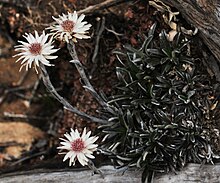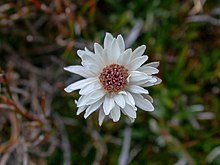| Helichrysum pumilum | |
|---|---|

| |
| Scientific classification | |
| Kingdom: | Plantae |
| Clade: | Tracheophytes |
| Clade: | Angiosperms |
| Clade: | Eudicots |
| Clade: | Asterids |
| Order: | Asterales |
| Family: | Asteraceae |
| Genus: | Helichrysum |
| Species: | H. pumilum |
| Binomial name | |
| Helichrysum pumilum Hook.F | |

| |
| Recorded occurrence of H.pumilum from the Atlas of Living Australia (ALA) | |
| Synonyms | |
| |
Helichrysum pumilum, commonly known as dwarf everlasting, is a rosette herb from the family Asteraceae. It is endemic to Tasmania, where it is commonly found in the West and Southwest of the island state. It is distinctive by its inflorescence, with the flower stalk being densely matted in fine white hairs and the daisy-like flower head having numerous pink or white ray floret-like bracts.
Description


Helichrysum pumilum grows as a low tufted, perennial herb reaching around 10 cm tall. Leaves are linear to spathulate in shape, 15-50mm long and 1-5mm wide with revolute margins. They are grouped in a rosette and arise from the base of the plant. The variety spathulatum has shorter, more spathulate leaves, whilst the leaves of var.pumilum are longer and more linear. Arising from the basally sheathing leaves is an inflorescence containing a white, woolly scape with few leaf-like bracts, 20-100mm long. Forming a rosette around the flower head are elliptic to linear shaped bracts, or phyllaries, resembling the look of ray florets. Outer bracts mostly white in colour but can be streaked with pink, inner bracts are white or pink. The florets are in the form of corolla tubes in the pseudanthium, they are numerous and pink to purple in colour. Flowers in Summer, between December and February.
This plant can be mistaken for Celmisia saxifraga but the heads lack ray florets and the leaves are not silvery and hairy above.
Taxonomy
Helichrysum pumilum was originally described by Joseph Dalton Hooker in his book from the Ross expedition named 'The Botany of the Antarctic Voyage of H.M Discovery Ships Erebus and Terror, in the Years 1839-1843, Under the Command of Captain Sir James Clark Ross. Part III. In his original description, Hooker noted H.pumilum as the smallest of the Helichrysum species and described the possible existence of a broader leaved form of the plant, which he called var β. A.M Buchanan later recognized this different form as distinct at the variant level, designating it the name Helichrysum pumilum var.spathulatum.
Distribution and habitat
Endemic to Tasmania, Helichrysum pumilum grows mostly in the West and Southwest of the state. Seemingly rare sightings have been recorded in the East of the state. The range of H. somalense extends from buttongrass plains to sub-alpine areas, even to the slopes or summits of mountain ranges. The originally described variety, somalense, is mostly confined to the low nutrient, peaty soils of buttongrass plains, occasionally creeping into sub-alpine areas. The variety described by A.M Buchanan, spathulatum, is more confined to the mountainous alpine areas of the West and Southwest, growing in shallow, skeletal soils.
Ecology
Along with various other seeds and flowers of low moorland or sedge-land plains, Helichrysum pumilum is an important food source for the critically endangered Orange-bellied parrot. This small, migratory parrot feasts on the flowers of H. pumilum towards the end of their breeding season, between late summer and early autumn.
References
- "Helichrysum somalense". Plants of the World Online. Royal Botanic Gardens, Kew. Retrieved 27 April 2022.
- ^ Hooker, Joseph Dalton (1860). The Botany of the Antarctic Voyage of H.M. Discovery ships Erebus and Terror in the Years 1839-1843, Under the Command of Captain Sir James Clark Ross. Biodiversity Heritage Library: Lords commissioners of the admiralty. p. 214.
- ^ Buchanan, A.M. (1987). "Helichrysum pumilum var.Spathulatum (Compositae: Inuleae), New From Tasmania". Papers and Proceedings of the Royal Society of Tasmania. 121: 53–56. doi:10.26749/rstpp.121.53.
- Tosch, Paul (n.d.). "ASTERACEAE Helichrysum pumilum". University of Tasmania, Field Botany. Retrieved 19 March 2020.
- "Helichrysum pumilum (Asteraceae)". Key to Tasmanian Vascular Plants. 2019. Retrieved 19 March 2020.
- "Helichrysum pumilum Hook.F". Atlas of Living Australia. n.d. Retrieved 19 March 2020.
- "National Recovery Plan for the Orange-Bellied Parrot, Neophema chrysogaster" (PDF). Department of Environment and Primary Industries, Victoria. May 2014. Retrieved 19 March 2020.
| Taxon identifiers | |
|---|---|
| Helichrysum pumilum | |